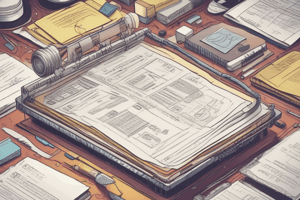Podcast
Questions and Answers
Which of the following is NOT a use of information technology in healthcare?
Which of the following is NOT a use of information technology in healthcare?
- Remote surgical procedures using robots
- Video conferencing for case discussions
- Enhancing radiology work
- Reducing the need for patient consultation (correct)
What are the three fundamental elements of a business process?
What are the three fundamental elements of a business process?
- Objectives, Resources, Outputs
- Inputs, Resources, Outputs (correct)
- Planning, Executing, Analyzing
- Feedback, Execution, Adjustments
Which of the following best describes efficiency in business processes?
Which of the following best describes efficiency in business processes?
- Minimizing time and resource wastage (correct)
- Maximizing customer engagement and satisfaction
- Creating the highest quality product
- Enhancing collaboration among departments
Cross-functional business processes require:
Cross-functional business processes require:
What does the term 'long tail' refer to in e-tailing?
What does the term 'long tail' refer to in e-tailing?
In the context of business processes, which of the following is an example of an output?
In the context of business processes, which of the following is an example of an output?
Which of the following best describes an electronic mall?
Which of the following best describes an electronic mall?
What is the primary function of intermediaries that can be fully automated or made obsolete?
What is the primary function of intermediaries that can be fully automated or made obsolete?
What metric emphasizes doing things that matter within a business process?
What metric emphasizes doing things that matter within a business process?
Which situation illustrates a cross-functional process?
Which situation illustrates a cross-functional process?
Which characteristic of EMV smart cards allows them to remain compatible with older payment methods?
Which characteristic of EMV smart cards allows them to remain compatible with older payment methods?
What is one limitation of e-tailing compared to traditional retailing?
What is one limitation of e-tailing compared to traditional retailing?
What factor contributes to lower competitive rivalry according to the provided information?
What factor contributes to lower competitive rivalry according to the provided information?
Which activity is categorized as a primary activity in the value chain model?
Which activity is categorized as a primary activity in the value chain model?
How do established companies gain a competitive advantage using customer data?
How do established companies gain a competitive advantage using customer data?
Which of the following best describes the nature of digital product costs after initial development?
Which of the following best describes the nature of digital product costs after initial development?
What is considered a support activity in an organization's value chain?
What is considered a support activity in an organization's value chain?
What does the inbound logistics activity involve?
What does the inbound logistics activity involve?
Which of the following activities creates value for which customers are willing to pay?
Which of the following activities creates value for which customers are willing to pay?
Which factor can lead to intense competition among firms?
Which factor can lead to intense competition among firms?
What characteristic defines support activities in the value chain?
What characteristic defines support activities in the value chain?
What is a defining characteristic of multidimensional data storage?
What is a defining characteristic of multidimensional data storage?
Which of the following are common source systems for data warehouses?
Which of the following are common source systems for data warehouses?
What role does data-profiling software play in a data warehousing project?
What role does data-profiling software play in a data warehousing project?
What is one major challenge organizations face with their source systems?
What is one major challenge organizations face with their source systems?
What is a primary function of metadata in a data warehouse?
What is a primary function of metadata in a data warehouse?
Which architecture aspect is crucial for data warehouses?
Which architecture aspect is crucial for data warehouses?
Why is it important to address multiple source systems in an organization?
Why is it important to address multiple source systems in an organization?
What type of data is becoming increasingly popular in modern data warehouses?
What type of data is becoming increasingly popular in modern data warehouses?
How do business intelligence (BI) capabilities often originate within organizations?
How do business intelligence (BI) capabilities often originate within organizations?
What is the primary difference in data updating processes between transactional databases and data warehouses?
What is the primary difference in data updating processes between transactional databases and data warehouses?
Which of the following is NOT a characteristic of a data warehouse?
Which of the following is NOT a characteristic of a data warehouse?
In what way are data marts considered advantageous compared to data warehouses?
In what way are data marts considered advantageous compared to data warehouses?
What type of processing do data warehouses utilize to support decision making?
What type of processing do data warehouses utilize to support decision making?
How does the organization of data differ between transactional databases and data warehouses?
How does the organization of data differ between transactional databases and data warehouses?
What is the primary advantage of storing data in a nonvolatile format in data warehouses?
What is the primary advantage of storing data in a nonvolatile format in data warehouses?
Why are data warehouses capable of supporting long-term trend analysis?
Why are data warehouses capable of supporting long-term trend analysis?
Which of the following best describes the integration of data in a data warehouse?
Which of the following best describes the integration of data in a data warehouse?
What is the main focus of online analytical processing (OLAP) as used in data warehouses?
What is the main focus of online analytical processing (OLAP) as used in data warehouses?
Which statement accurately reflects the nature of transactional databases compared to data warehouses?
Which statement accurately reflects the nature of transactional databases compared to data warehouses?
Flashcards
Business Process
Business Process
A series of related activities that produce a valuable product or service for the organization, its partners, or customers.
Process Inputs
Process Inputs
Materials, services, and information that are changed or transformed during the process.
Process Resources
Process Resources
People and equipment that perform process tasks.
Process Outputs
Process Outputs
Signup and view all the flashcards
Process Efficiency
Process Efficiency
Signup and view all the flashcards
Process Effectiveness
Process Effectiveness
Signup and view all the flashcards
Cross-Functional Process
Cross-Functional Process
Signup and view all the flashcards
Industry rivalry threat
Industry rivalry threat
Signup and view all the flashcards
Competitive advantage (firms)
Competitive advantage (firms)
Signup and view all the flashcards
Digital product variable cost
Digital product variable cost
Signup and view all the flashcards
Porter's Value Chain Model
Porter's Value Chain Model
Signup and view all the flashcards
Value Chain
Value Chain
Signup and view all the flashcards
Primary activities
Primary activities
Signup and view all the flashcards
Support activities
Support activities
Signup and view all the flashcards
Inbound logistics
Inbound logistics
Signup and view all the flashcards
Outbound logistics
Outbound logistics
Signup and view all the flashcards
Stored-value money cards
Stored-value money cards
Signup and view all the flashcards
EMV smart cards
EMV smart cards
Signup and view all the flashcards
E-tailing
E-tailing
Signup and view all the flashcards
Disintermediation
Disintermediation
Signup and view all the flashcards
Value-added services
Value-added services
Signup and view all the flashcards
Data Warehouse
Data Warehouse
Signup and view all the flashcards
Data Mart
Data Mart
Signup and view all the flashcards
Why Data Warehouses and Marts?
Why Data Warehouses and Marts?
Signup and view all the flashcards
OLTP vs. OLAP
OLTP vs. OLAP
Signup and view all the flashcards
Data Integration
Data Integration
Signup and view all the flashcards
Time Variance in Data Warehouses & Marts
Time Variance in Data Warehouses & Marts
Signup and view all the flashcards
Nonvolatile Data
Nonvolatile Data
Signup and view all the flashcards
Organized by Subject
Organized by Subject
Signup and view all the flashcards
Benefits of Data Warehouses & Marts
Benefits of Data Warehouses & Marts
Signup and view all the flashcards
Data Warehouses in Business
Data Warehouses in Business
Signup and view all the flashcards
Data Cube
Data Cube
Signup and view all the flashcards
Business Dimensions
Business Dimensions
Signup and view all the flashcards
Source Systems
Source Systems
Signup and view all the flashcards
Data Profiling
Data Profiling
Signup and view all the flashcards
Multidimensional Data
Multidimensional Data
Signup and view all the flashcards
Metadata
Metadata
Signup and view all the flashcards
Data Governance
Data Governance
Signup and view all the flashcards
Bad Data
Bad Data
Signup and view all the flashcards
Study Notes
Introduction to Management Information System
- Information technology (IT) is any computer-based tool used to work with information and support organizational needs.
- Information systems (IS) collect, process, store, analyze, and disseminate information for a specific purpose, and are often computer-based, though not mandatory (manual book-keeping could be considered an IS).
- Management information systems (MIS) is a business function, similar to marketing, finance, or human resources, dealing with planning and developing, managing, and using IT for information processing and management.
- Business technology management (BTM) is another name for IS.
- Digital transformation (DT) uses IT to improve employee, customer, and partner relationships.
Why Study Information Systems?
- IT offers many career opportunities.
- Understanding IT helps you select and use IT applications properly.
- Understanding IT enhances security awareness.
- IT improves business performance.
- IT is important for entrepreneurs.
- Example questions include how hackers gain access to systems and how to use social engineering.
Studying That Suits You
Use AI to generate personalized quizzes and flashcards to suit your learning preferences.




